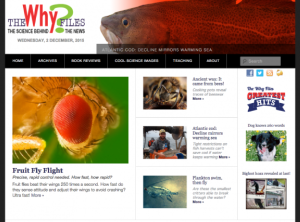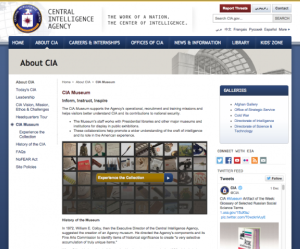Research and Education |
 |
The Why Files |
Science |
|
The Why Files, created and based at the University of Wisconsin-Madison with funding support from the National Science Foundation, will be a boon to any science teacher. Each week the site publishes a new story that digs into "the science behind the news," providing readers with an erudite overview of the scientific issues that shape our world. Recent topics have included information about possible breakthroughs in the quest for an effective male contraceptive, how warming seas are affecting the cod population, and an expose on "flying" plankton. Educators searching for ways to enrich their lesson plans will want to scout the Archives, which go all the way back to 1999 and cover such topic as Arts & Humanities, Biology, Earth & Space, Environment, Health, and others. Additionally, the Teaching tab is loaded with helpful material, including suggested Why Files that meet the National Science Education Standards and Classroom Activities (discussion questions, quizzes, etc.) on popular topics ranging from tsunamis to the flu vaccine. [CNH] |
|





|
|
 |
IssueLab |
Social studies |
|
For educators who don't have access to giant university databases, paywalls can sometimes feel like a major impediment to the information and knowledge they'd like to share with their students. IssueLab can help overcome that difficulty. A service of the Foundation Center, the Lab "works to more effectively gather, index, and share the collective intelligence of the social sector." Here educators will find over 18,000 (and counting) resources related to the world's most pressing social quandaries. Readers may scout the site using the Explore function, which will sort resources by Authors, Issue Areas, and Geography, as well as by Special Collections related to topics such as Affordable Care Act, Arts Education, Gun Violence, Immigration Strategies, and many others. Readers may also conduct a keyword or advanced search if looking for more targeted material. In sum, this compendium of case studies, evaluations, white papers, and issue briefs is sure to inspire teachers of social studies, the humanities, earth science, and other subject areas.[CNH] |
|





|
|
 |
ScienceNetLinks: Today in Science |
Science |
|
Today in Science provides an enlivening daily peek into the history of the scientific enterprise. Each day, ScienceNetLinks, a project of the American Association for the Advancement of Science (AAAS), publishes a two-paragraph gloss of an important event in the history of science. For instance, November 24th corresponds to the day that Charles Darwin published his earth-shaking treatise, On the Origin of Species, in 1859. After perusing the short description of this monumental event, users may then link to a host of resources from ScienceNetLinks, such as collections about Darwin, a section about what we can learn from fossils, a comparison of the competing evolutionary theories of Lamarck and Darwin, a page dedicated to the evolution of feathers, and a game based on the theory of natural selection. Rather than limiting users to a particular day in history, a handy calendar feature lets users select any date of interest. With 365 entries to choose from, educators are sure to find inspiring material for classroom discussions, daily trivia, or a variety of other educational activities. [CNH] |
|





|
|
 |
Youngzine |
Social studies |
|
Youngzine seeks to "help parents and educators create a vibrant community of globally aware young citizens in an increasingly connected world." Using simple, direct language and engaging visuals, the site presents complex global events in a way that will engage elementary and middle school students. Readers may explore the site through categories such as World News, Science & Tech, Our Earth, and Society & Arts. In the Classrooms action of the site, Teachers may opt to sign up their classes for Youngzine, in which each class is assigned a unique "Classroom Code" and teachers are provided with a safe classroom blog where they may post assignments and garner student responses. The U Write section, which publishes the writing of students, is also engaging and relevant to students of all ages. Here, students may write and submit (with parent or teacher approval) their own creative material, such as articles, poems, or book reviews. [CNH] |
|





|
|
 |
Edudemic |
Educational Technology |
|
Founded in 2010, Edudemic is focused on connecting educators, administrators, parents, and even students to technology resources and ideas. However, the site truly shines as a resource for Educators. Interested readers may like to start by scouting the attractive landing page, where they will find recently published articles on such topics as how to confront bullying, what drone technologies can teach students, fresh ways to engage students, and tips on everything from bringing YouTube into the classroom to the appropriate use of Wikipedia. From there, readers may like to scout the categories of Teacher's Guides and For Teachers. This first category contains excellent articles on how to leverage Twitter, Google Glass, and the Library of Congress in the classroom, while the second covers such topic as News, Online Learning, Social Media, Tools, Trends, and Videos. Educators looking for ways to integrate technologies into their classrooms will find many ideas on this continually updated site. [CNH] |
|





|
|
 |
|
 |
Project I'm Ready |
Educational Technology |
|
As the site notes, Project I'm Ready has two primary goals. First, the organization seeks to "educate 21st century school librarians to serve in culturally diverse, high poverty rural areas of Oklahoma, serving Native American students." Second, the project hopes "to develop and disseminate culturally sensitive, digital curriculum and learning resources to improve K-12 pedagogy in the targeted areas." While many readers will not be working with populations in Oklahoma, the site is an excellent example of culturally relevant pedagogy. After perusing the About Project I'm Ready section, readers may like to select ENTER to see excellent videos of Cherokee artisans, as well as librarians speaking about their dedication to making information relevant to diverse populations. In addition, readers will find presentations, activities, and handouts dedicated to serving the Cherokee population of Oklahoma, in particular, and diverse populations in general. [CNH] |
|





|
|
 |
C. Roland Christensen Center for Teaching & Learning: Case Method in Practice |
Vocational Education |
|
The C. Roland Christensen Center for Teaching and Learning endeavors to make classes at the Harvard Business School dynamic and engaging. However, educators everywhere can benefit from the teaching and learning resources the center provides; the Case Method in Practice section is no exception. For instance, Chris Christensen described case method teaching as "the art of managing uncertainty," in which an instructor acts as "planner, host, moderator, devil's advocate, fellow-student, and judge," making for an interactive, open-ended, and collaborative learning process. Here readers will find subsections devoted to a variety of case method "dimensions," such as Core Principles, Sample Class, Preparing to Teach, Leading in the Classroom, and Providing Assessment and Feedback. Each of these subsections offers up tidbits of wisdom and suggestions for making classrooms work. Though the resources here are aimed at Harvard Business School teachers, readers everywhere will find much to ponder in the free videos, downloadable PDFs, and other resources available here. [CNH] |
|





|
|
























